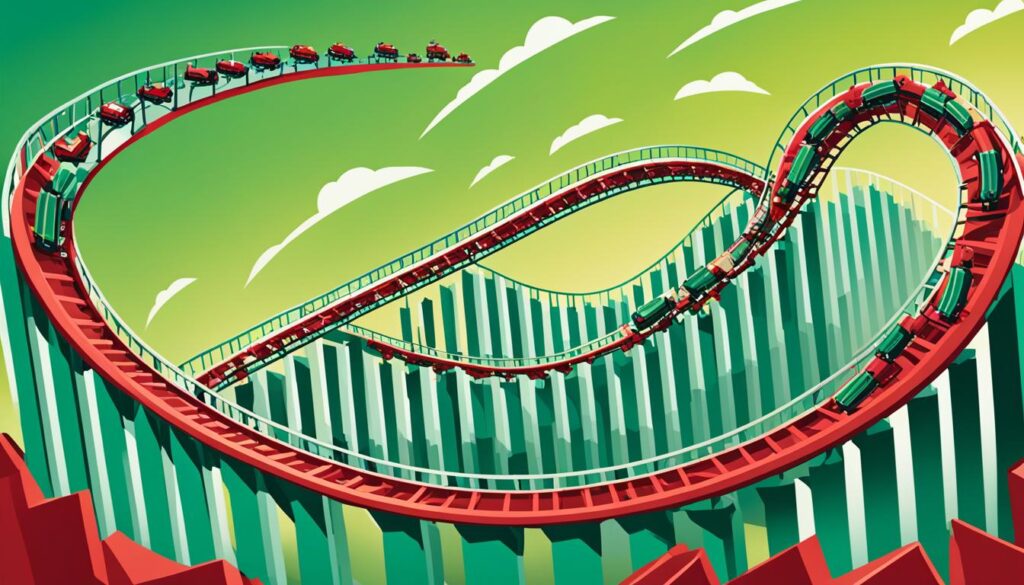“As an Amazon Associate I earn from qualifying purchases.”
In the unpredictable waters of our economy, over 40% of industry leaders in the United States are now bracing for the emergence of a “rolling recession”. Unlike the widespread economic havoc typically associated with downturns, this lesser-known phenomenon presents a shifting battleground across various sectors. From tech lay-offs to leaps in leisure, these economic fluctuations reflect the very definition of a rolling recession—a cascade of sector-by-sector downturns that toggle the financial health of industries. You’re about to embark on a journey to uncover what this means, why it’s happening, and how to strategically navigate through the rippling effects of economic downturn strategies.
Key Takeaways
- Rolling recession marks a distinct type of economic slowdown impacting sectors individually rather than the economy as a whole.
- Understanding the rolling recession definition can help you strategize and alleviate its impacts on your investments and career.
- Contrary to a traditional recession, a rolling recession can exhibit job market resilience in unaffected industries, emphasizing the need for a diversified career approach.
- Economic downturn strategies differ in a rolling recession, often requiring a more targeted and adaptable response.
- Keeping abreast of economic fluctuations across sectors is paramount for businesses and individuals aiming to maintain a competitive edge during these uncertain times.
Deciphering the Rolling Recession Phenomenon
As you delve into the complexities of the ongoing economic climate, it’s vital to understand the subtleties that define a rolling recession. Unlike widespread economic turbulence, this form of recession is marked by its sequential impact on various industry sectors. Analyzing how these sector-specific recessions play out and their implications on GDP growth provides valuable insights into the economy’s trajectory.
Defining the Rolling Recession
The term “rolling recession” encapsulates an economic situation where the downturn is staggered across different sectors rather than striking the economy in unison. This variation allows certain areas to recuperate while others face economic challenges, softening the blow to the overall economy and preventing a skyfall into deeper recessions.

Comparing Hard and Soft Recession Outcomes
Different recession outcomes, such as hard-landing and soft-landing recessions, profoundly affect the labor market and overall economic health. A hard-landing recession, often characterized by severe layoffs and stagnant economic growth, stands in contrast to the milder soft-landing, where the market slows down but avoids a complete stall, maintaining enough inertia to eventually rebound.
GDP as a Recession Indicator
The Gross Domestic Product (GDP) remains a powerful tool in gauging the economic vitality of a nation. A downturn indicated by consecutive quarters of GDP contraction heralds the onset of a recession, serving as a clear signal for economists and policymakers to brace for and address the impending economic challenges.
| Recession Type | Characteristics | Impact on GDP Growth | Impact on Labor Market |
|---|---|---|---|
| Rolling | Sector-by-sector downturn | Varied effect, may show localized dips | Disparate, with some sectors showing resilience |
| Hard-landing | Extensive layoffs, contracted economy | Significant decrease | Widespread job loss |
| Soft-landing | Moderate slowdown, minimal disruption | Mild decrease or stabilization | Relatively stable or minor job losses |
Profile of a Rolling Recession
As the economic landscape shifts, a deeper understanding of how rolling recessions operate becomes imperative. Unlike uniform downturns, these periods are characterized by sector-specific downturns, displaying a patchwork of challenges and recoveries across various industries.

Diving into Sector-Specific Impacts
The mosaic of the current economic environment highlights notable discrepancies from one industry to the next. Recessionary patterns have notably emerged within the housing sector, a traditional bellwether of broader economic health. Following the surge in demand throughout the pandemic, the housing market has experienced a contraction. This is evidenced by the downturn in both home sales and new construction starts—classic markers of economic recovery patterns beginning to wane.
Furthermore, the manufacturing and technology sectors have not been immune to these tumultuous shifts. For months, manufacturing output has wavered, signaling potential hurdles ahead. In the tech arena, once booming with pandemic-driven demand, we see a recalibration with significant entities like Amazon and Meta now resizing their workforce, aligned with the notion of job market resilience being tested.
The Dynamic Nature of Job Markets During Rolling Recessions
Job markets reveal a dichotomy in resilience during rolling recessions, with certain sectors demonstrating more vulnerability to economic headwinds. In the tech sector, for instance, behemoths of the industry have faced a reckoning, letting go of employees in response to a post-pandemic decline in demand. This contrasts sharply with the hiring surges seen in healthcare, hospitality, and leisure, underscoring the uneven distribution of impact across different employment areas and the overall dynamic nature of the job market.
| Sector | Impact | Trend |
|---|---|---|
| Housing | Decreased Sales and Construction | Early signs of sector-specific downturns |
| Manufacturing | Wavering Production Outputs | Potential for extended slowdown |
| Technology | Workforce Downsizing | Adjustment to Post-Pandemic Demand |
| Hospitality and Leisure | Employment Growth | Continued resilience in certain job markets |
| Healthcare | Hiring Surges | Sustained demand and job market strength |
Understanding these trends is crucial for navigating the unpredictable waters of rolling recessions. Tune into sector-specific signals, prepare for fluctuations in the job market, and keep an eye on varying economic recovery patterns. This knowledge will empower you to adapt and stay resilient, regardless of your industry.
Telltale Signs of the Rolling Recession
The economic landscape is constantly transforming, and the emergence of rolling recessions has introduced new complexities. As certain sectors feel the pressure while others remain buoyant, understanding the indicators of these economic shifts is crucial. Recognizing these signs can empower you to navigate through these uncertain times more adeptly.
The Housing Market as an Early Indicator
Observing the housing market trends offers valuable foresight into the economic trajectory. Initially resilient, the sector has begun to demonstrate signs of fatigue. The dip in activity, from slowing home sales to stalling construction projects, embodies recession indicators that shouldn’t be overlooked. The housing market often precursors broader economic shifts, and its current state could be a harbinger of more pervasive downturns.
Manufacturing and Tech Sector Vulnerabilities
The manufacturing sector slowdown has mirrored the hesitant spending of consumers. While capacity lingers, demand struggles to maintain momentum, setting the stage for potential workforce reductions and a scaling back of production. Notably, the tech layoff wave highlights the precarious nature of a previously booming industry—a testament to the sector’s sensitivity to economic headwinds and changing consumer priorities.
Consumer Spending and Its Implications
Consumer spending provides the pulse to the veins of the economy; when it recedes, the consequences cascade through various sectors. Higher interest rates and cost-of-living increases have incentivized a more conservative spending approach. As expendable incomes contract, so does the demand for goods and services ranging from retail to entertainment, drawing a comprehensive yet patchy pattern of recessionary pressure.
Rolling Recession Vs. Traditional Economic Downturns
As you delve into the nuances of economic history, it’s crucial to discern the intricate dance between rolling recession dynamics and the triggers of traditional economic downturns. Traditional recessions have historically been precipitated by definitive factors such as asset bubbles bursting, sharp stock market crashes, and severe drops in consumer confidence. These factors, generally resulting from a singular event or a combination of catastrophic events, have led to widespread economic paralysis. Reflecting on events like the subprime mortgage crisis or the cataclysmic Great Depression, it’s apparent how these economic shocks echoed across the entire landscape, leaving deep and enduring scars.
Historical Recessions: Cause and Effect Analysis
When we consider traditional recession triggers, the outcomes they foster often emanate from a centralized source of economic upheaval. The depth of impact is such that recovery requires systemic correction and stabilization. Recovery narratives from these historical downturns offer poignant lessons in the resilience and adaptability of economies. Central to these traditional recessions is a domino effect where one sector’s collapse can drag down the others rapidly, reflecting a monolithic economic environment.
The Unique Triggers of Rolling Recessions
In stark contrast stand rolling recessions, a concept capturing your attention as you explore the present and future of the economy. These downturns stem not from one precipitous event but emerge out of a tapestry of smaller, interwoven occurrences selectively influencing different sectors. The modern economy, displaying rolling recession dynamics, is marked by intricate fluctuations in post-pandemic consumer behavior and a demand shift between goods and services. The asymmetric recovery patterns observed across sectors suggest a complex and evolving impact—one that precludes the synchronized plunge typical of traditional economic downturns. Understanding this multi-threaded reality offers an insightful lens into the nature of current and future economic evolutions.
FAQ
What is the definition of a rolling recession?
How does a rolling recession differ from traditional hard and soft recessions?
Can GDP growth accurately predict a rolling recession?
How do sector-specific impacts signal a rolling recession?
Why is the job market’s reaction so varied during a rolling recession?
How does the housing market serve as an early indicator of a rolling recession?
What vulnerabilities do the manufacturing and tech sectors face during a rolling recession?
Why is consumer spending important in understanding a rolling recession?
What distinguishes the causes of traditional recessions from rolling recessions?
Are there unique triggers associated with rolling recessions?
Source Links
- https://www.rba.gov.au/education/resources/explainers/recession.html
- https://www.whitehouse.gov/wp-content/uploads/2022/12/TTC-EC-CEA-AI-Report-12052022-1.pdf
- https://www.forbes.com/advisor/investing/what-is-a-recession/
- https://www.whitehouse.gov/cea/written-materials/2022/07/21/how-do-economists-determine-whether-the-economy-is-in-a-recession/
- https://www.businessinsider.com/personal-finance/recession-vs-depression
- https://www.mckinsey.com/featured-insights/mckinsey-explainers/what-is-a-recession
- https://www.investopedia.com/terms/d/demandshock.asp
- https://en.wikipedia.org/wiki/Recession
- https://www.mckinsey.com/capabilities/risk-and-resilience/our-insights/somethings-coming-how-us-companies-can-build-resilience-survive-a-downturn-and-thrive-in-the-next-cycle
“As an Amazon Associate I earn from qualifying purchases.”

